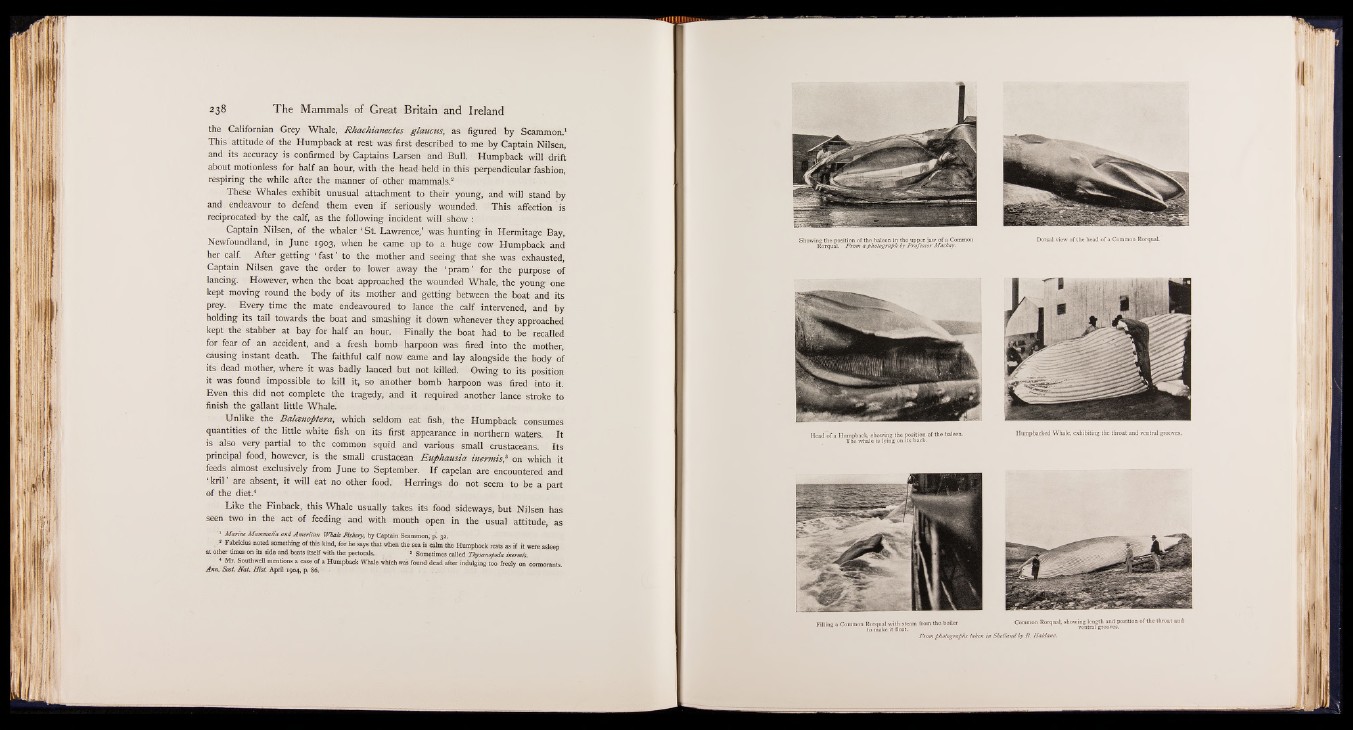
the Californian Grey Whale, Rhachianectes glaucus, as figured by Scammon.1
This attitude of the Humpback at rest was first described to me by Captain Nilsen,
and its accuracy is confirmed by Captains Larsen and Bull. Humpback will drift
about motionless for half an hour, with the head- held in this perpendicular fashion,
respiring the while after the manner of other mammals.2
These Whales exhibit unusual attachment to their young, and will stand by
and endeavour to defend them even if seriously wounded. This affection is
reciprocated by the calf, as the following incident will show :
Captain Nilsen, of the whaler ‘ St. Lawrence,’ was hunting in Hermitage Bay,
Newfoundland, in June 1903, when he came up to a huge cow Humpback and
her calf. After getting ‘ fast’ to the mother and seeing that she was exhausted,
Captain Nilsen gave the order to lower away the ‘ pram’ for the purpose of
lancing. However, when the boat approached the wounded Whale, the young one
kept moving round the body of its mother and getting between the boat and its
prey. Every time the mate endeavoured to lance the calf intervened, and by
holding its tail towards the boat and smashing it down whenever they approached
kept the stabber at bay for half an hour. Finally the boat had to be recalled
for fear of an accident, and a fresh bomb harpoon was fired into the mother,
causing instant death. The faithful calf now came and lay alongside the body of
its dead mother, where it was badly lanced but not killed. Owing to its position
it was found impossible to kill it, so another bomb harpoon was fired into it.
Even this did not complete the tragedy, and it required another lance stroke to
finish the gallant little Whale.
Unlike the Baleznoptera, which seldom eat fish, the Humpback consumes
quantities of the little white fish on its first appearance in northern waters. It
is also very partial to the common squid and various small crustaceans. Its
principal food, however, is the small crustacean Euphausia inerwiis,8 on which it
feeds almost exclusively from June to September. I f capelan are encountered and
‘ kril are absent, it will eat no other food. Herrings do not seem to be a part
of the diet.4
Like the Finback, this Whale usually takes its food sideways, but Nilsen has
seen two in the act of feeding and with mouth open in the usual attitude, as
-1 Marine Mammalia and American Whale Fishery, by Captain Scammon, 32.
* Fabridus noted something of this kind, for he says that when the sea is calm the Humpback rests as if it were asleep
at other times on its side and beats itself with the pectorals. . . * Sometimes called Thysanofoda inermis.
* Mr. Southwell mentions a case of a Humpback Whale which was found dead after indulging too freely on cormorants.
Ann. Scot. Nat. H ist. April 1904, p. 86. • -
Humpbacked Whale, exhibiting the throat and ventral grooves.
Head of a Humpback, showing the position of the baleen.
The whale is lying on its back.
n from the boiler
From photographs taken